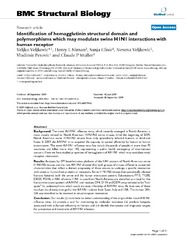Приказ основних података о документу
Identification of hemagglutinin structural domain and polymorphisms which may modulate swine H1N1 interactions with human receptor
| dc.creator | Veljković, Veljko | |
| dc.creator | Niman, Henry L. | |
| dc.creator | Glišić, Sanja | |
| dc.creator | Veljković, Nevena V. | |
| dc.creator | Perović, Vladimir R. | |
| dc.creator | Muller, Claude P. | |
| dc.date.accessioned | 2018-03-01T20:56:28Z | |
| dc.date.available | 2018-03-01T20:56:28Z | |
| dc.date.issued | 2009 | |
| dc.identifier.issn | 1471-2237 | |
| dc.identifier.uri | https://vinar.vin.bg.ac.rs/handle/123456789/3801 | |
| dc.description.abstract | Background: The novel A/H1N1 influenza virus, which recently emerged in North America is most closely related to North American H1N1/N2 swine viruses. Until the beginning of 2009, North American swine H1N1/N2 viruses have only sporadically infected humans as dead-end hosts. In 2009 the A/H1N1 virus acquired the capacity to spread efficiently by human to human transmission. The novel A/H1N1 influenza virus has struck thousands of people in more than 70 countries and killed more than 140, representing a public health emergency of international concern. Here we have studied properties of hemagglutinin of A/H1N1 which may modulate virus/receptor interaction. Results: Analyses by ISM bioinformatics platform of the HA1 protein of North American swine H1N1/N2 viruses and the new A/H1N1 showed that both groups of viruses differed in conserved characteristics that reflect a distinct propensity of these viruses to undergo a specific interaction with swine or human host proteins or receptors. Swine H1N1/N2 viruses that sporadically infected humans featured both the swine and the human interaction pattern. Substitutions F71S, T128S, E302K, M314L in HA1 of swine H1N1 viruses from North America are identified as critical for the human interaction pattern of A/H1N1 and residues D94, D196 and D274 are predicted to be hotspots for polymorphisms which could increase infectivity of A/H1N1 virus. At least one of these residues has already emerged in the A/H1N1 isolates from Spain, Italy and USA. The domain 286-326 was identified to be involved in virus/receptor interaction. Conclusion: Our results (i) contribute to better understanding of the origin of the novel A/H1N1 influenza virus, (ii) provide a tool for monitoring its molecular evolution (iii) predicts hotspots associated with enhanced infectivity in humans and (iv) identify therapeutic and diagnostic targets for prevention and treatment of A/H1N1 infection. | en |
| dc.relation | Ministry of Science and Technological Development of the Republic of Serbia [143001], COST Action [B28] | |
| dc.rights | openAccess | en |
| dc.source | BMC Structural Biology | en |
| dc.title | Identification of hemagglutinin structural domain and polymorphisms which may modulate swine H1N1 interactions with human receptor | en |
| dc.type | article | en |
| dcterms.abstract | Ниман, Хенрy Л.; Муллер, Цлауде П.; Вељковић Вељко; Глишић Сања; Вељковић Невена В.; Перовић Владимир; | |
| dc.citation.volume | 9 | |
| dc.identifier.wos | 000270717400001 | |
| dc.identifier.doi | 10.1186/1472-6807-9-62 | |
| dc.citation.other | Article Number: 62 | |
| dc.citation.rank | M22 | |
| dc.identifier.pmid | 19785758 | |
| dc.identifier.scopus | 2-s2.0-70349900418 | |
| dc.identifier.fulltext | https://vinar.vin.bg.ac.rs//bitstream/id/12561/3797.pdf |

